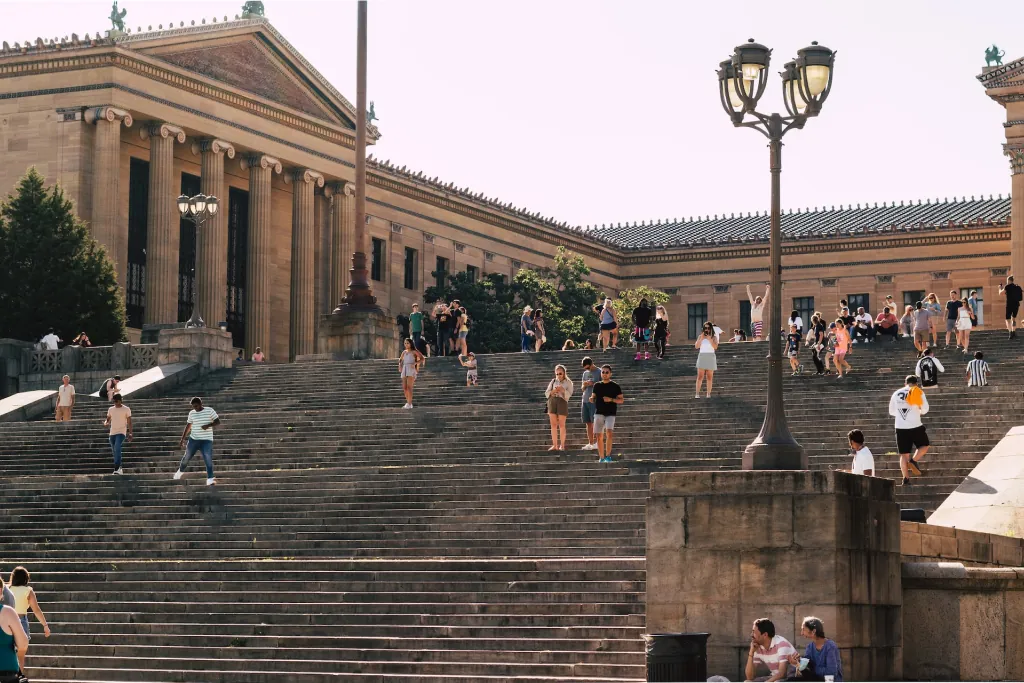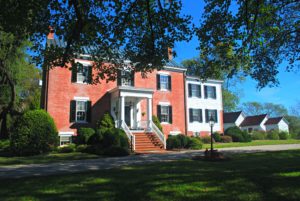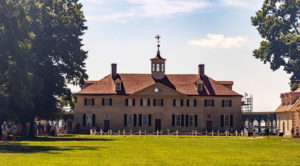Photo by kevin laminto on Unsplash
Are you planning a trip to Virginia and looking for the best recommendations for must-see Virginia historic sites? We’ve got your back!
We compiled the top 15 most important historic sites in Virginia for you to visit and explore. Whether you’re a history buff or just looking for a fun day trip, these sites offer a glimpse into Virginia’s rich past and cultural heritage.
Read on to know them all and spot your most wanted landmark to visit!
1. Colonial Williamsburg
When it comes to living history museums, no one compares to Colonial Williamsburg.
This historic site in Virginia reopened its doors in 1926 after its rehabilitation. It is the largest open-air museum in the country, featuring two world-class art museums, numerous historic inns, and a bustling trading community across its 301-acre territory.
Colonial Williamsburg is always welcoming visitors. The Evening Programs run late into the night, so you can stop by after work if you can’t visit the site during day time. Its art museums are open every day of the year from 10 AM to 6 PM.
2. Cape Henry Lighthouse
Near the “First Landing” site where English immigrants stepped foot for the first time on their way to Jamestown stands the Cape Henry Lighthouse, the first publicly-funded project by the United States Government.
The lighthouse has helped keep ships safe as they entered and left the Chesapeake Bay for many years. Two lighthouses watch over the entrance to the Chesapeake Bay today at Cape Henry. They are so significant that the United States government has recognized them as a National Historic Landmark and added them to the National Register of Historic Places.
Here are some guidelines to remember if you are planning to visit Cape Henry Lighthouse:
- Visitors with valid Department of Defense or Military IDs will be granted access to the Cape Henry Lighthouse via vehicle.
- All guests are required to present proper identification at all times.
- The vehicle's driver must be able to present registration and insurance documentation.
- ONLY ADA service animals are allowed. However, they cannot ascend the last stairway to the lighthouse's observation deck due to safety concerns.
- Guests can walk or ride their bikes onto the base with proper identification.
- Prohibited are narcotics, booze, and other contraband.
- If caught with illegal goods, entry to the base will be denied.
- All guests are subject to a thorough background check.
3. Bacon's Castle
The earliest brick house in North America was constructed in 1665 for a family named Allen and named Bacon’s Castle. Nathaniel Bacon and his soldiers holed up in the mansion for months in 1676 during the infamous revolt called Bacon’s Rebellion.
Bacon’s Castle was built in the exceptional High Jacobean style and featured an exquisite traditional English garden from the 17th century which the Garden Club of Virginia restored. Also preserved are several outbuildings, including a slave house from the 1830s.
4. John Marshall House
The museum enlightens visitors about the Great Chief Justice, John Marshall, and his Richmond mansion and the enslaved people who labored during the early time. The John Marshall House, on the National and Virginia Historic Registers, has mostly stayed the same since Marshall was alive.
Visit the museum store, stroll around the vibrant garden, play a game of quoits, or take an in-depth look at the historic home of the then-Great Chief Justice of Virginia!
5. Lee Chapel at the University Chapel & Galleries
In 1867, Robert E. Lee, Washington College’s 1865-1870 president, requested the Lee Chapel on the original primary site of Washington and Lee University. It was designed in the Victorian style and constructed under the supervision of Gen. Robert E. Lee in 1868.
The Lee Chapel also serves as the campus’s spiritual focal point. It keeps the office of Robert E. Lee essentially as he left it on September 28, 1870, just two weeks before his death.
6. Monticello
Monticello is a famous UNESCO World Heritage Site and one of Virginia’s notable historic sites. It was once the home of Thomas Jefferson and is now a sought-after tourist destination in the state.
Over forty years and numerous redesigns, constructions, and demolitions later, Thomas Jefferson’s Monticello stands as his autobiographical masterwork. Its gardens featured varieties of attractive and valuable flowers from all over the world.
You can learn more about the life of Thomas Jefferson, the man behind the University of Virginia and the Declaration of Independence, and the third President of the United States by visiting Monticello.
7. Peyton Randolph House
The Peyton Randolph House is a great place to learn about American slavery and how enslaved people in one family battled for freedom from their masters while still fighting to be treated as human beings.
When booking a ticket, there are various selections you can choose from. Check out their ticket and membership rates as follows:
| Ticket | Price - Adult | Price - Youth (Aged 6-12) |
|---|---|---|
| Single-Day | $49.99 | $28.99 |
| Multi-Day | $59.99 | $33.99 |
| Annual Pass | $74.99 | $41.99 |
| Good Neighbor Pass | $19.99 | $9.99 |
| Art Museums Single-Day | $14.99 | $8.99 |
| America’s Historic Triangle | $119.00 (aged 16 and up) | $53.00 (aged 6 to15) |
| Summer Bounce | $168.23 | $145.23 |
| Museum Family Membership | $125.00 | $10.00 (youth add-on) |
| Museum Individual Membership | $60.00 | $25.00 (aged 6-17) |
8. St. John's Church
St. John’s Church, or Henrico Parish Church as it is more commonly known, was an important landmark leading up to the American Revolution.
The Second Virginia Convention took place in this historic site in Virginia in March 1775. As hostilities between the American colonies and Great Britain escalated, this convention became an important gathering of colonial leaders.
Patrick Henry gave a speech to the convention in which he famously proclaimed, “Give me liberty or give me death!” This speech became a rallying cry for those fighting for independence and is widely considered one of the most impactful in American history.
St. John’s Church, a landmark from the Revolutionary War, still stands today. It is an integral part of Virginia’s culture, with a museum offering guided tours so that people can learn about its historical significance to the United States.
9. White House of the Confederacy
The museum is a great place to spend some time in Richmond if you’re interested in history and want to learn more about the people who once resided in the area. As part of the permanent exhibits of the American Civil War Museum, the White House is accessible to the general public.
Confederate President Jefferson Davis, together with his family, lived in the White House of the Confederacy, also known as the Confederate White House, during the American Civil War. The Confederate White House was the center of government and social life during the war. Cabinet meetings and visits from foreign ambassadors and dignitaries were held at Jefferson Davis’ home.
The Confederate White House was taken by Union soldiers in 1865 after the end of the Civil War. It underwent significant alterations when it became the headquarters for several Union military departments. The home was purchased in 1890 by the Confederate Memorial Association, which then opened it as a museum after restoring it to its appearance during the Age of the Confederacy.
Learn about Jefferson Davis and the Confederate government on a tour of his home in Virginia. The complicated history and lasting impact of the Confederacy are the subjects of the museum’s exhibitions and educational programs.
10. Manassas National Battlefield
Another important historic site in Virginia is the famous Manassas National Battlefield Park. It remembers the First and Second Battle of Bull Run, which were pivotal in the American Civil War.
The areas where the war took place are now protected in Manassas National Battlefield Park. Visitors can learn about the plans, tactics, and sacrifices made by the Union and Confederate armies as they explore the park’s fields, woodlands, and historic structures.
You can learn more about the wars and their impact on American history by taking advantage of the park’s walking paths, guided tours, and interpretive displays!
11. First Landing State Park
Initially settled by English colonists in 1607, First Landing State Park cypress swamps provided a critical supply of fresh water to passing ships throughout the War of 1812.
The park’s rivers have been traveled by canoes belonging to Native Americans, colonial settlers, twentieth-century schooners, and modern cargo ships. During the Civil War, Union and Confederate patrols patrolled the interior waterways, and it is said that Blackbeard hid in the Narrows portion of the park.
The park is now a National Natural Landmark in Virginia, offering many activities for guests. See them for yourselves and experience a great day in First Landing State Park!
12. Jamestown Settlement
The Jamestown Settlement is home to the ruins of North America’s first permanent English settlement. It includes the Ambler Mansion from the 18th century, artifacts from the area’s settlers on display in a museum, and reconstructions of a 17th-century fort and a Powhatan Native American village.
Visitors to the museum can learn about the experiences of the first English colonists to settle in Jamestown in 1607. It is an interesting and informative way to learn about the Jamestown colony’s impact on the development of the United States as a whole.
13. Arlington National Cemetery
Over 14,000 people, including many Civil War veterans, are buried in this 639-acre cemetery, making it one of the oldest national burial grounds in the country. The cemetery is most famous for the Tomb of the Unknown Soldier, which has the remains of unknown warriors from many wars.
Arlington National Cemetery is a quiet place to honor and reflect on the sacrifices made by those who have served their country. If you plan to visit this historical site in Virginia, here are some things you should know:
- All visitors aged 16 and up must show proper identification at the cemetery's entrance.
- All friends and family of the deceased, as well as tourists and government officials, are considered visitors.
- Tour guides and teachers leading groups of students must also show proper identification. You must use original paperwork. No IDs taken on a phone or printed out from the computer will be accepted.
- Anyone above the age of 18 visiting the United States is required to provide a government-issued photo ID.
- If a visitor is 16 or 17 years old and does not have a government-issued picture ID from the United States, they may submit a government-issued photo ID from their school instead.
- A valid passport or any government-issued picture identification issued by the United States is required of all visitors who are not U.S. citizens.
14. Edgar Allan Poe Museum
The life and works of the famous American author Edgar Allan Poe are the subjects of exhibits at the Edgar Allan Poe Museum. It is a monument to Poe’s literary legacy and contributions.
The museum displays a variety of Edgar Allan Poe-related objects, including manuscripts, personal items, and memorabilia. Exhibits about Poe’s life, writings, and influence on American literature and culture are also available for exploration.
15. American Revolution Museum at Yorktown

Photo by Luisa Frassier on Unsplash
The American Revolution Museum at Yorktown examines the revolutionary conflict in the Americas and how it contributed to the formation of the United States.
The museum’s interactive displays teach visitors everything they need to know about the Revolutionary War era. At the American Revolution Museum in Yorktown, you may watch a film called “The Siege of Yorktown,” which takes you inside the pivotal fight that led to the British capitulation and changed the course of the war forever.
Visitors can experience a deeper understanding of the Revolutionary War and a greater respect for the brave men and women who fought for American independence.
Wrap Up
Virginia is a beautiful place holding precious memories of past events that have significantly impacted the state’s development.
Visiting different historic sites in Virginia is learning about the state’s history and appreciating the beauty of the place and the people who have made it what it is today. It has a rich and diverse history that is worth exploring. So, pack your bags and explore the beauty and history of Virginia!
If you wish to know more about the state or would like to inquire more about the historic homes in Virginia, such as Equestrian Estates or Exquisite Farmhouses, please do not hesitate to contact me anytime!
You can reach me by calling (434) 960-0161 or emailing Pam@PamDent.com for any inquiries you may have about the historic state of Virginia. Also, feel free to follow me on my social media platforms to receive the latest trends and updates about the state!

Photo by Henry Deng on Unsplash
Frequently Asked Questions
What are 5 historical sites someone might want to visit in Virginia?
Below are the five historical sites in Virginia that someone might like to visit. These places are some of the most known historic sites in the area that you should see!
- Jamestown Settlement
- Monticello
- Colonial Williamsburg
- Arlington National Cemetery
- First Landing State Park
How many historical sites are in Virginia?
There are over 100 historical sites that can be found in Virginia! It’s the place to be, especially for history lovers and enthusiasts!
What is a historical site in Virginia?
Objects of political, cultural, military, or social significance are often given state protection as historical sites or heritage sites.
Many historic locations have been granted the prestigious title of “national historic site” by the federal government, further guaranteeing their legal protection.
Any structure, landscape, or place with great local, regional, or national historical significance can be designated as a historic site.



